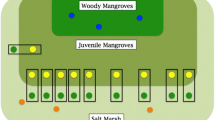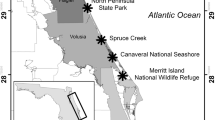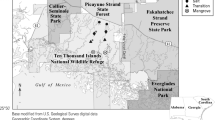Abstract
Coastal wetland vegetation communities can respond to sea level rise via the encroachment of more salt- and inundation-tolerant species into existing vegetation communities. Black mangroves (Avicennia germinans L.) are encroaching on saltgrass (Distichlis spicata L.) within the Merritt Island National Wildlife Refuge in east central Florida (USA). Nine soil cores collected along three transects captured the transitions of both perceived abiotic drivers (salinity and inundation) and vegetation communities during both high- and low-water seasons to investigate patterns in soil biogeochemical cycling of carbon (C), nitrogen (N), and phosphorus (P). Results showed no change in soil carbon dioxide production along the ecotone during either season, though changes in enzyme activity and mineralization rates of N and P could indicate changes in C quality and nutrient availability affecting C degradation along the ecotone. All parameters, excluding microbial biomass carbon, showed higher rates of activity or availability during the low-water season. Long-term soil nutrient stores (total C, N, P) were greatest in the saltgrass soils and similar between the mangrove and transition zone soils, indicating a ‘tipping point’ in biogeochemical function where the transition zone is functionally equivalent to the encroaching mangrove zone. Indicators of current biogeochemical cycling (that is, enzyme activity, potentially mineralizable N rates, and extractable ammonium concentrations) showed alterations in activity across the ecotone, with the transition zone often functioning with lower activity than within end members. These indicators of current biogeochemical cycling change in advance of full vegetation shifts. Increases in salinity and inundation were linked to mangrove encroachment.








Similar content being viewed by others
References
Akaike H. 1974. A new look at the statistical identification model. IEEE Trans Automat Contr 19:716.
Akaike H. 1983. Information measures and model selection. Int Stat Inst 44:277–91.
Allison SD, Weintraub MN, Gartner TB, Waldrop MP. 2011. Evolutionary-economic principles as regulators of soil enzyme production and ecosystem Function. In: Shukla G, Varma A, Eds. Soil enzymology. Berlin: Springer. pp 229–43. https://doi.org/10.1007/978-3-642-14225-3_12.
Andersen JM. 1976. An ignition method for determination of total phosphorus in lake sediments. Water Res 10:329–31. https://doi.org/10.1016/0043-1354(76)90175-5.
Barreto CR, Morrissey EM, Wykoff DD, Chapman SK. 2018. Co-occurring mangroves and salt marshes differ in microbial community composition. Wetlands 38:497–508.
Bertness MD. 1991. Zonation of Spartina Patens and Spartina Alterniflora in New England salt marsh. Ecology 72:138–48. https://doi.org/10.2307/1938909.
Bianchi TS, Allison MA, Zhao J, Li X, Comeaux RS, Feagin RA, Kulawardhana RW. 2013. Historical reconstruction of mangrove expansion in the Gulf of Mexico: Linking climate change with carbon sequestration in coastal wetlands. Estuar Coast Shelf Sci 119:7–16. http://www.sciencedirect.com/science/article/pii/S027277141200457X. Accessed 30/03/2017.
Bonferroni CE. 1936. Teoria statistica delle classi e calcolo delle probabilità. Pubblicazioni del R Istituto Superiore di Scienze Economiche e Commerciali di Firenze 8:3–62.
Bouillon S, Connolly RM, Lee SY. 2008. Organic matter exchange and cycling in mangrove ecosystems: recent insights from stable isotope studies. J Sea Res 59:44–58.
Bozdogan H. 1987. Model selection and akaike’s information criterion (AIC): the general theory and its analytical extensions. Psychometrika 52:345–70. https://doi.org/10.1007/BF02294361.
Brannon JM. 1973. Seasonal variation of nutrients and physicochemical properties in the salt marsh soils of Barataria Bay, Louisiana.
Bridgham SD, Ye R. 2013. Organic matter mineralization and decomposition. In: DeLaune RD, Reddy KR, Richardson CJ, Megonigal JP, Eds. Methods in Biogeochemistry of Wetlands, SSSA Book Series 10. Madison, WI: SSSA. pp 385–406. https://doi.org/10.2136/sssabookser10.c20.
Brockmeyer RE, Hinkle CR, Collazo JA, Blum LK, Cahoon DR, Stewart JB, Provancha MJ, Scheidt DM. 2005. Wetlands initiative at Merritt Island national wildlife refuge: project overview, site description and history. Tech Bull Fla Mosq Control Assoc 6:14–15.
Burnham KP, Anderson DR. 2002. Model selection and multimodel inference: a practical information-theoretic approach. New York: Ecol Model.
Cavanaugh KC, Kellner JR, Forde AJ, Gruner DS, Parker JD, Rodriguez W, Feller IC. 2014. Poleward expansion of mangroves is a threshold response to decreased frequency of extreme cold events. Proc Natl Acad Sci 111:723 LP-727. http://www.pnas.org/content/111/2/723.abstract.
Clarke LD, Hannon NJ. 1970. The mangrove swamp and salt marsh communities of the Sydney district: III. Plant growth in relation to salinity and waterlogging. J Ecol 58:351–69.
Comeaux RS, Allison MA, Bianchi TS. 2012. Mangrove expansion in the Gulf of Mexico with climate change: implications for wetland health and resistance to rising sea levels. Estuar Coast Shelf Sci 96:81–95.
DeLaune RD, Reddy KR, Richardson CJ, Megonigal JP. 2013. Methods in biogeochemistry of wetlands. Madison: Soil Science Society of America.
Donnelly JP, Bertness MD. 2001. Rapid shoreward encroachment of salt marsh cordgrass in response to accelerated sea-level rise. Proc Natl Acad Sci U S A 98:14218–23.
Doughty CL, Langley JA, Walker WS, Feller IC, Schaub R, Chapman SK. 2016. Mangrove range expansion rapidly increases coastal wetland carbon storage. Estuaries Coasts 39:385–96.
Duarte CM, Losada IJ, Hendriks IE, Mazarrasa I, Marbà N. 2013. The role of coastal plant communities for climate change mitigation and adaptation. Nat Clim Change 3:961. https://doi.org/10.1038/nclimate1970.
Dunn OJ. 1961. Multiple comparisons among means. J Am Stat Assoc 56:52–64. https://www.tandfonline.com/doi/abs/10.1080/01621459.1961.10482090.
Dunn C, Jones TG, Girard A, Freeman C. 2014. Methodologies for extracellular enzyme assays from wetland soils. Wetlands 34:9–17.
Egler FE. 1952. Southeast saline Everglades vegetation, Florida and its management. Vegetatio 3:213–65.
Feller IC. 1995. Effects of nutrient enrichment on growth and herbivory of dwarf red mangrove (Rhizophora mangle). Ecol Monogr 65:477–505.
Feller IC, Whigham DF, O’Neill JP, McKee KL. 1999. Effects of nutrient enrichment on within-stand cycling in a mangrove forest. Ecology 80:2193–205.
Feller IC, Whigham DF, Mckee KL, Lovelock CE. 2003. Nitrogen limitation of growth and nutrient dynamics in a disturbed mangrove forest, Indian River Lagoon, Florida. Oecologia 134:405–14.
Feller IC, Chamberlain AH, Piou C, Chapman S, Lovelock CE. 2013. Latitudinal patterns of herbivory in mangrove forests: consequences of nutrient over-enrichment. Ecosystems 16:1203–15.
Field CB, Osborn JG, Hoffman LL, Polsenberg JF, Ackerly DD, Berry JA, Björkman O, Held A, Matson PA, Mooney HA. 1998. Mangrove biodiversity and ecosystem function. Glob Ecol Biogeogr 7:3–14.
Foster TE, Stolen ED, Hall CR, Schaub R, Duncan BW, Hunt DK, Drese JH. 2017. Modeling vegetation community responses to sea-level rise on Barrier Island systems: a case study on the Cape Canaveral Barrier Island complex, Florida, USA. PLoS One 12:1–22. https://doi.org/10.1371/journal.pone.0182605.
Henry KM, Twilley RR. 2013. Soil development in a coastal Louisiana wetland during a climate-induced vegetation shift from salt marsh to mangrove. J Coast Res 292:1273–83. http://www.bioone.org/doi/abs/10.2112/JCOASTRES-D-12-00184.1.
Kelleway JJ, Saintilan N, Macreadie PI, Skilbeck CG, Zawadzki A, Ralph PJ. 2016. Seventy years of continuous encroachment substantially increases ‘blue carbon’ capacity as mangroves replace intertidal salt marshes. Glob Chang Biol 22:1097–109.
Kelleway JJ, Cavanaugh K, Rogers K, Feller IC, Ens E, Doughty C, Saintilan N. 2017. Review of the ecosystem service implications of mangrove encroachment into salt marshes. Glob Chang Biol 23:3967–83.
Kirwan ML, Megonigal JP. 2013. Tidal wetland stability in the face of human impacts and sea-level rise. Nature 504:53. https://doi.org/10.1038/nature12856.
Krauss KW, Lovelock CE, McKee KL, López-Hoffman L, Ewe SML, Sousa WP. 2008. Environmental drivers in mangrove establishment and early development: a review. Aquat Bot 89:105–27. http://www.sciencedirect.com/science/article/pii/S0304377008000089.
Krauss KW, From AS, Doyle TW, Doyle TJ, Barry MJ. 2011. Sea-level rise and landscape change influence mangrove encroachment onto marsh in the Ten Thousand Islands region of Florida, USA. J Coast Conserv 15:629–38.
Lewis DB, Brown JA, Jimenez KL. 2014. Effects of flooding and warming on soil organic matter mineralization in Avicennia germinans mangrove forests and Juncus roemerianus salt marshes. Estuar Coast Shelf Sci 139:11–19. https://doi.org/10.1016/j.ecss.2013.12.032.
Livesley SJ, Andrusiak SM. 2012. Temperate mangrove and salt marsh sediments are a small methane and nitrous oxide source but important carbon store. Estuar Coast Shelf Sci 97:19–27. http://www.sciencedirect.com/science/article/pii/S0272771411004537.
Lugo AE, Snedaker SC. 1974. The ecology of mangroves. Annu Rev Ecol Syst 5:39–64. https://doi.org/10.1146/annurev.es.05.110174.000351.
Lunstrum A, Chen L. 2014. Soil carbon stocks and accumulation in young mangrove forests. Soil Biol Biochem 75:223–32. http://www.sciencedirect.com/science/article/pii/S003807171400128X.
McKee K, Rogers K, Saintilan N. 2012. Response of Salt Marsh and Mangrove Wetlands to Changes in Atmospheric CO2, Climate, and Sea Level. In: Middleton BA, Ed. Global change and the function and distribution of wetlands. Dordrecht: Springer. pp 63–96. https://doi.org/10.1007/978-94-007-4494-3_2.
Middleton BA, Mckee KL. 2014. Degradation of mangrove tissues and implications for peat formation in Belizean island forests. J Ecol 89:818–28.
Morris JT, Sundareshwar P V, Nietch CT, Kjerfve B, Cahoon DR. 2002. Responses of coastal wetlands to rising sea level. Ecology 83:2869–77. http://www.esajournals.org/doi/full/10.1890/0012-9658(2002)083[2869:ROCWTR]2.0.CO;2.
Osland MJ, Spivak AC, Nestlerode JA, Lessmann JM, Almario AE, Heitmuller PT, Russell MJ, Krauss KW, Alvarez F, Dantin DD, Harvey JE, From AS, Cormier N, Stagg CL. 2012. Ecosystem development after mangrove wetland creation: plant–soil change across a 20-year chronosequence. Ecosystems 15:848–66.
Perry CL, Mendelssohn IA. 2009. Ecosystem effects of expanding populations of Avicennia germinans in a Louisiana salt marsh. Wetlands 29:396–406. http://link.springer.com/10.1672/08-100.1.
Pontee N. 2013. Defining coastal squeeze: a discussion. Ocean Coast Manag 84:204–7. http://www.sciencedirect.com/science/article/pii/S0964569113001786.
Raabe EA, Roy LC, McIvor CC. 2012. Tampa Bay coastal wetlands: nineteenth to twentieth century tidal marsh-to-mangrove conversion. Estuaries Coasts 35:1145–62.
Reddy KR, DeLaune RD. 2008. Biogeochemistry of wetlands: science and applications. CRC Press https://books.google.com/books?id=8yLE_tMMTl8C.
Rogers K, Wilton KM, Saintilan N. 2006. Vegetation change and surface elevation dynamics in estuarine wetlands of southeast Australia. Estuar Coast Shelf Sci 66:559–69. http://www.sciencedirect.com/science/article/pii/S0272771405003562.
Ross MS, Meeder JF, Sah JP, Ruiz PL, Telesnicki GJ. 2000. The southeast saline Everglades revisited: 50 years of coastal vegetation change. J Veg Sci 11:101–12. http://www.science.fau.edu/biology/gawliklab/papers/RossMS-etal2000.pdf.
Roy ED, White JR. 2013. Measurements of nitrogen mineralization potential in wetland soils. In: Methods in biogeochemistry of wetlands. SSSA Book Series SV-10. Madison: Soil Science Society of America. pp 465–71. http://dx.doi.org/10.2136/sssabookser10.c24.
Saintilan N, Wilson NC, Rogers K, Rajkaran A, Krauss KW. 2014. Mangrove expansion and salt marsh decline at mangrove poleward limits. Glob Chang Biol 20:147–57.
Scholander PF, van Dam L, Scholander SI. 1955. Gas exchange in the roots of mangroves. Am J Bot 42:92–8.
Simpson LT, Feller IC, Chapman SK. 2013. Effects of competition and nutrient enrichemnt on Avicennia germinans in the salt marsh-mangrove ecotone. Aquat Bot 104:55–9.
Simpson LT, Osborne TZ, Duckett LJ, Feller IC. 2017. Carbon storages along a climate induced coastal wetland gradient. Wetlands 37:1–13.
Simpson LT, Osborne TZ, Feller IC. 2019. Wetland soil Co2 efflux along a latitudinal gradient of spatial and temporal complexity. Estuaries Coasts 42:45–54. https://doi.org/10.1007/s12237-018-0442-3.
Steinmuller HE, Chambers LG. 2018. Can saltwater intrusion accelerate nutrient export from freshwater wetland soils? an experimental approach. Soil Sci Soc Am J 82:283–92. https://doi.org/10.2136/sssaj2017.05.0162.
Tabatabai MA. 2003. Soil enzymes. In: Encyclopedia of agrochemicals. American Cancer Society https://onlinelibrary.wiley.com/doi/abs/10.1002/047126363X.agr354.
Torio DD, Chmura GL. 2013. Assessing coastal squeeze of tidal wetlands. J Coast Res 29:1049–61.
Wolanski E. 1992. Hydrodynamics of mangrove swamps and their coastal waters. Hydrobiologia 247:141–61.
Yando ES, Osland MJ, Willis JM, Day RH, Krauss KW, Hester MW, McCulley R. 2016. Salt marsh-mangrove ecotones: using structural gradients to investigate the effects of woody plant encroachment on plant-soil interactions and ecosystem carbon pools. J Ecol 104:1020–31.
Acknowledgements
The authors would like to thank the entirety of the Aquatic Biogeochemistry Laboratory for their field assistance, especially Dr. Joshua Breithaupt and Nia Hurst for their helpful comments on the manuscript. We would also like to acknowledge Russell Lowers and Dr. Paul Schmalzer for their help in the field and invaluable knowledge of the site.
Author information
Authors and Affiliations
Corresponding author
Additional information
Author’s Contribution
HES, TEF, CRH, and LGC conceived and designed the study. H. Steinmuller performed research, analyzed data, and wrote the paper. PB performed research. All authors contributed to editing the manuscript.
Electronic Supplementary Material
Below is the link to the electronic supplementary material.
Rights and permissions
About this article
Cite this article
Steinmuller, H.E., Foster, T.E., Boudreau, P. et al. Tipping Points in the Mangrove March: Characterization of Biogeochemical Cycling Along the Mangrove–Salt Marsh Ecotone. Ecosystems 23, 417–434 (2020). https://doi.org/10.1007/s10021-019-00411-8
Received:
Accepted:
Published:
Issue Date:
DOI: https://doi.org/10.1007/s10021-019-00411-8




